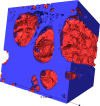Detailed three-dimensional analyses of tyloses in oak used for bourbon and wine barrels through X-ray computed tomography
- PMID: 39048642
- PMCID: PMC11269640
- DOI: 10.1038/s41598-024-67298-x
Detailed three-dimensional analyses of tyloses in oak used for bourbon and wine barrels through X-ray computed tomography
Abstract
American white (Quercus alba L.) oak casks have been used for liquid storage for centuries. Their use in aged spirits is critical to imparting flavor and mouthfeel to the final product. The reason that barrels retain liquid has been hypothesized to be the result of abundant physiological structures called tyloses in parenchyma tissues and medullary rays in white oak. Using non-destructive X-ray computed tomography (XRCT) imaging, we reveal an unprecedented view of tylose structure and quantify the pore-filling capacity of tyloses in white oak that underscores the liquid retention we observe in casks. We show that pores of white oaks are filled with sevenfold higher tylose volume compared to northern red oak (Q. rubra), consistent with prior literature that casks made from white oak retain liquid while red oak fails to do so. We propose that XRCT represents a methodological standard for observing these complex structures and should be employed to understand the many questions related to liquid losses from casks, cultural treatment of casks, and the influence of climate change on oak tyloses in the future.
© 2024. The Author(s).
Conflict of interest statement
The authors declare no competing interests.
Figures






References
-
- Kirsch, S. The Origin and Development of Resin Canals in the Coniferae with Special Reference to the Development of Thyloses and their Correlation with the Thylosal Strands of the Pteridophytes (McGill University, 1910).
-
- Sachs, I., Kuntz, J., Ward, J., Nair, G. & Schultz, N. Tyloses structure. Wood Fiber Sci., 259–268 (1970).
-
- De Micco, V., Balzano, A., Wheeler, E. A. & Baas, P. Tyloses and gums: A review of structure, function and occurrence of vessel occlusions. IAWA J.37, 186–205. 10.1163/22941932-20160130 (2016).10.1163/22941932-20160130 - DOI
-
- HAMPSHIRE, N. & DAKOTA, S. The Discovery of Tylose Formation by a Viennese Lady in 1845 MH Zimmerman, Harvard Forest Petersham, Massachusetts 01366 USA.
MeSH terms
LinkOut - more resources
Full Text Sources
Medical
Miscellaneous

